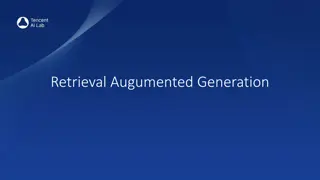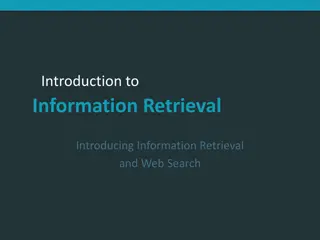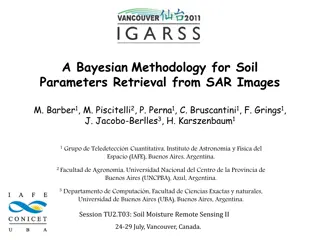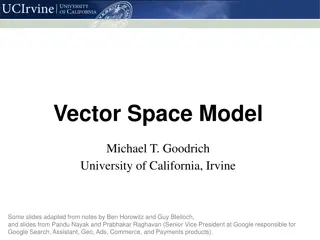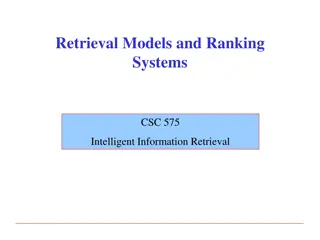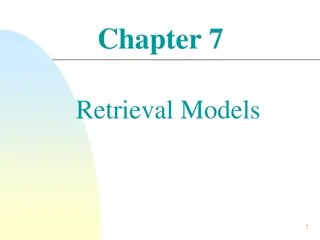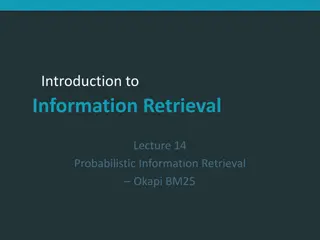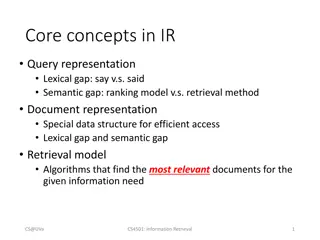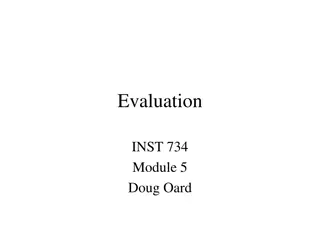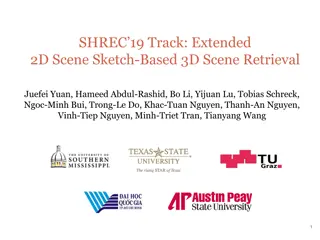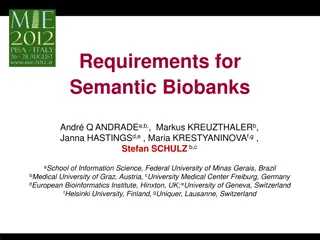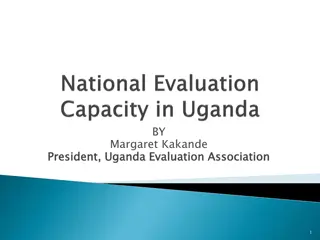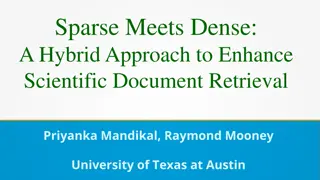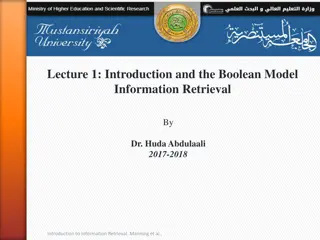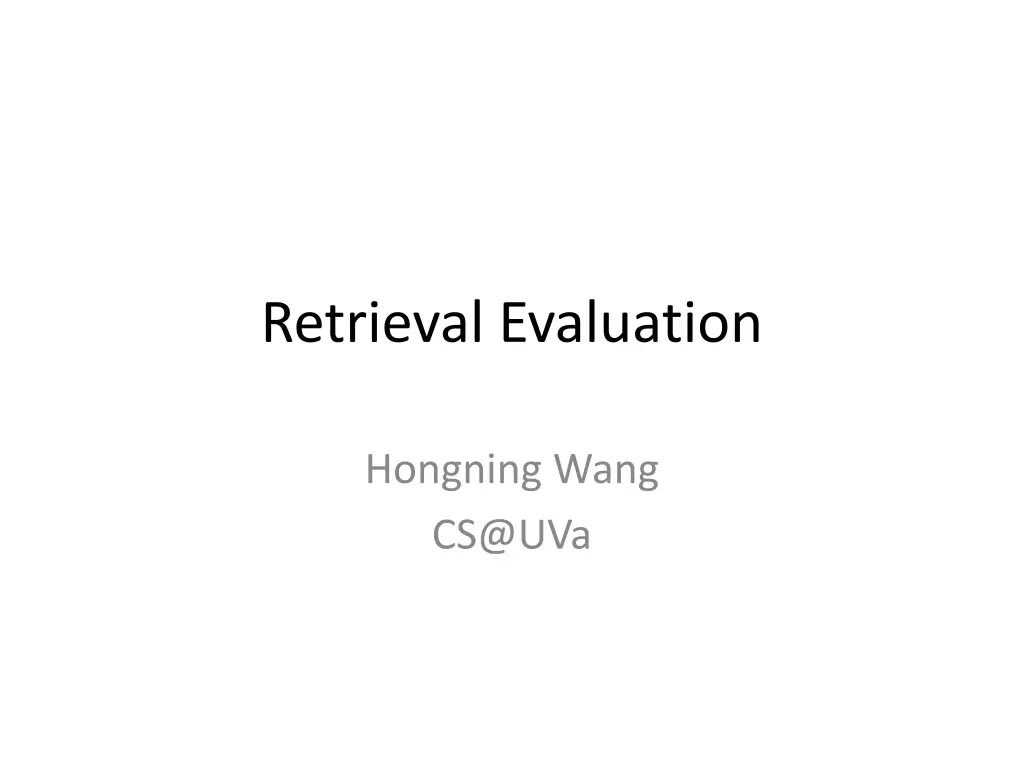
IR Quality Measurement and Evaluation Overview
Explore the fundamentals of IR quality measurement and evaluation, covering topics such as indexed corpus, retrieval systems, user satisfaction criteria, and classical IR evaluation methodologies. Learn about information retrieval processes, user needs categorization, and satisfaction metrics to enhance information systems performance.
Download Presentation

Please find below an Image/Link to download the presentation.
The content on the website is provided AS IS for your information and personal use only. It may not be sold, licensed, or shared on other websites without obtaining consent from the author. If you encounter any issues during the download, it is possible that the publisher has removed the file from their server.
You are allowed to download the files provided on this website for personal or commercial use, subject to the condition that they are used lawfully. All files are the property of their respective owners.
The content on the website is provided AS IS for your information and personal use only. It may not be sold, licensed, or shared on other websites without obtaining consent from the author.
E N D
Presentation Transcript
Retrieval Evaluation Hongning Wang CS@UVa
What we have learned so far Indexed corpus Crawler Ranking procedure Research attention Feedback Evaluation Doc Analyzer (Query) User Query Rep Doc Rep (Index) results Ranker Indexer Index CS@UVa CS 4780: Information Retrieval 2
CS@UVa CS4780: Information Retrieval 3
Which search engine do you prefer: Bing or Google? What are your judging criteria? How fast does it respond to your query? How many documents can it return? CS@UVa CS 4780: Information Retrieval 4
Which search engine do you prefer: Bing or Google? What are your judging criteria? Can it correct my spelling errors? Can it suggest me good related queries? CS@UVa CS 4780: Information Retrieval 5
Retrieval evaluation Aforementioned evaluation criteria are all good, but not essential Goal of any IR system Satisfying users information need Core quality measure how well a system meets the information needs of its users. wiki Unfortunately vague and hard to execute CS@UVa CS 4780: Information Retrieval 6
Quantify the IR quality measure Information need an individual or group's desire to locate and obtain information to satisfy a conscious or unconscious need wiki Reflected by user query Categorization of information need Navigational Informational Transactional CS@UVa CS 4780: Information Retrieval 7
Quantify the IR quality measure Satisfaction the opinion of the user about a specific computer application, which they use wiki Reflected by Increased result clicks Repeated/increased visits Result relevance CS@UVa CS 4780: Information Retrieval 8
Classical IR evaluation Cranfield experiments Pioneer work and foundation in IR evaluation Basic hypothesis Retrieved documents relevance is a good proxy of a system s utility in satisfying users information need Procedure 1,398 abstracts of aerodynamics journal articles 225 queries Exhaustive relevance judgments of all (query, document) pairs Compare different indexing systems over such collection CS@UVa CS 4780: Information Retrieval 9
Classical IR evaluation Three key elements for IR evaluation 1. A document collection 2. A test suite of information needs, expressible as queries 3. A set of relevance judgments, e.g., binary assessment of either relevant or non-relevant for each query-document pair CS@UVa CS 4780: Information Retrieval 10
Search relevance Users information needs are translated into queries Relevance is judged with respect to the information need, not the query E.g., Information need: When should I renew my Virginia driver s license? Query: Virginia driver s license renewal Judgment: whether a document contains the right answer, e.g., every 8 years; rather than if it literally contains those four words CS@UVa CS 4780: Information Retrieval 11
Text REtrieval Conference (TREC) Large-scale evaluation of text retrieval methodologies Since 1992, hosted by NIST Standard benchmark for IR studies A wide variety of evaluation collections Web track Question answering track Cross-language track Microblog track And more CS@UVa CS 4780: Information Retrieval 12
Public benchmarks Table from Manning Stanford CS276, Lecture 8 CS@UVa CS 4780: Information Retrieval 13
Welcome back We will start our discussion at 2pm sli.do event code: 59907 Paper presentation schedule has been finalized MP1 is due this Friday, 11:59pm CS@UVa CS4780: Information Retrieval 14
Evaluation metric To answer the questions Is Google better than Bing? Which ranking method is the most effective? Shall we perform stemming or stopword removal? We need a quantifiable metric, by which we can compare different IR systems As unranked retrieval sets As ranked retrieval results CS@UVa CS 4780: Information Retrieval 15
Evaluation of unranked retrieval sets In a Boolean retrieval system Precision: fraction of retrieved documents that are relevant, i.e., p(relevant|retrieved) Recall: fraction of relevant documents that are retrieved, i.e., p(retrieved|relevant) Precision: relevant nonrelevant ?? ? = retrieved true positive (TP) false positive (FP) ?? + ?? not retrieved false negative (FN) true negative (TN) ?? Recall: ? = ?? + ?? CS@UVa CS 4780: Information Retrieval 16
Evaluation of unranked retrieval sets Precision and recall trade off against each other Precision decreases as the number of retrieved documents increases (unless in perfect ranking), while recall keeps increasing These two metrics emphasize different perspectives of an IR system Precision: prefers systems retrieving fewer documents, but highly relevant Recall: prefers systems retrieving more documents CS@UVa CS 4780: Information Retrieval 17
Evaluation of unranked retrieval sets Summarizing precision and recall to a single value In order to compare different systems F-measure: weighted harmonic mean of precision and recall, ? balances the trade-off 1 ?1 2 ? = ?1= ?+ 1 ?1 1 ?+1 ? ? Why harmonic mean? System1: P:0.53, R:0.36 System2: P:0.01, R:0.99 Equal weight between precision and recall H A 0.429 0.445 0.019 0.500 CS@UVa CS 4780: Information Retrieval 18
Evaluation of ranked retrieval results Ranked results are the core feature of an IR system Precision, recall and F-measure are set-based measures, which cannot assess the ranking quality Solution: evaluate precision at every recall point System1 System2 precision x Which system is better? x x x x x x x x recall x CS@UVa CS 4780: Information Retrieval 19
Precision-Recall curve A sawtooth shape curve Interpolated precision: ???????? = max precision found for any recall level ? ?. ? ??(? ), highest 1.0 0.8 Precision 0.6 0.4 0.2 0.0 0.0 0.2 0.4 0.6 0.8 1.0 Recall CS@UVa CS 4780: Information Retrieval 20
Evaluation of ranked retrieval results Summarize the ranking performance with a single number Binary relevance Eleven-point interpolated average precision Precision@K (P@K) Mean Average Precision (MAP) Mean Reciprocal Rank (MRR) Multiple grades of relevance Normalized Discounted Cumulative Gain (NDCG) CS@UVa CS 4780: Information Retrieval 21
Eleven-point interpolated average precision At the 11 recall levels [0,0.1,0.2, ,1.0], compute arithmetic mean of interpolated precision over all the queries 1 0.8 0.6 Precision 0.4 0.2 0 0 0.2 0.4 Recall 0.6 0.8 1 CS@UVa CS 4780: Information Retrieval 22
Precision@K Set a ranking position threshold K Ignores all documents ranked lower than K Compute precision in these top K retrieved documents E.g., P@3 of 2/3 P@4 of 2/4 P@5 of 3/5 In a similar fashion we have Recall@K Relevant Nonrelevant CS@UVa CS 4780: Information Retrieval 23
Mean Average Precision Consider rank position of each relevant doc E.g.,K1, K2, KR Compute P@K for each K1, K2, KR Average precision = average of those P@K E.g., 1 1+2 3+3 ??????? = /3 5 MAP is the mean of Average Precision across multiple queries/rankings CS@UVa CS 4780: Information Retrieval 24
AvgPrec is about one query Figure from Manning Stanford CS276, Lecture 8 AvgPrec of the two rankings CS@UVa CS 4780: Information Retrieval 25
MAP is about a system Figure from Manning Stanford CS276, Lecture 8 Query 1, AvgPrec=(1.0+0.67+0.5+0.44+0.5)/5=0.62 Query 2, AvgPrec=(0.5+0.4+0.43)/3=0.44 MAP = (0.62+0.44)/2=0.53 CS@UVa CS 4780: Information Retrieval 26
MAP metric If a relevant document never gets retrieved, we assume the precision corresponding to that relevant document to be zero MAP is macro-averaging: each query counts equally MAP assumes users are interested in finding many relevant documents for each query MAP requires many relevance judgments in a text collection CS@UVa CS 4780: Information Retrieval 27
Mean Reciprocal Rank Measure the effectiveness of the ranked results Suppose users are only looking for one relevant document looking for a fact known-item search navigational queries query auto completion Search duration ~ Rank of the answer Measures a user s effort CS@UVa CS 4780: Information Retrieval 28
Mean Reciprocal Rank Consider the rank position, ?, of the first relevant document Reciprocal Rank = 1 ? MRR is the mean RR across multiple queries CS@UVa CS 4780: Information Retrieval 29
Welcome back We will start our discussion at 2pm sli.do event code: 59907 Instruction for the survey paper has been posted MP1 is due this Friday, 11:59pm CS@UVa CS4780: Information Retrieval 30
Recap: evaluation of ranked retrieval results Ranked results are the core feature of an IR system Precision, recall and F-measure are set-based measures, which cannot assess the ranking quality Solution: evaluate precision at every recall point System1 System2 precision x Which system is better? x x x x x x x x recall x CS@UVa CS 4780: Information Retrieval 31
Beyond binary relevance P@6 MAP MRR Excellent Same P@6?! Fair Good Same MAP?! Fair Bad Relevant Nonrelevant Good Fair Fair Bad Bad Bad CS@UVa CS 4780: Information Retrieval 32
Beyond binary relevance The level of documents relevance quality with respect to a given query varies Highly relevant documents are more useful than marginally relevant documents The lower the ranked position of a relevant document is, the less useful it is for the user, since it is less likely to be examined Discounted Cumulative Gain CS@UVa CS 4780: Information Retrieval 33
Discounted Cumulative Gain Uses graded relevance as a measure of usefulness, or gain, from examining a document Gain is accumulated starting at the top of the ranking and discounted at lower ranks Typical discount is 1/log (rank) With base 2, the discount at rank 4 is 1/2, and at rank 8 it is 1/3 CS@UVa CS 4780: Information Retrieval 34
Discounted Cumulative Gain DCG is the total gain accumulated at a particular rank position p: Relevance label at position i ? ???? log2? ????= ???1+ ?=2 Alternative formulation ? 2???? 1 log2(1 + ?) ????= ?=1 Standard metric in some web search companies Emphasize on retrieving highly relevant documents CS@UVa CS 4780: Information Retrieval 35
Normalized Discounted Cumulative Gain Normalization is useful for contrasting queries with varying numbers of relevant results Normalize DCG at rank n by the DCG value at rank n of the ideal ranking The ideal ranking is achieved via ranking documents with their relevance labels CS@UVa CS 4780: Information Retrieval 36
How about P@4, P@5, MAP and MRR? NDCG - Example 5 documents: d1, d2, d3, d4, d5 Ground Truth Ranking Function1 Ranking Function2 i Document Order Document Order Document Order reli reli reli 1 d5 4 d3 2 d5 4 2 d4 3 d4 3 d3 2 3 d3 2 d2 1 d4 3 4 d2 1 d5 4 d1 0 5 d1 0 d1 0 d2 1 NDCGGT=1.00 NDCGRF1=0.67 NDCGRF2=0.97 24 1 log22+ 22 1 log22+ 24 1 log22+ 23 1 log23+ 23 1 log23+ 22 1 log23+ 22 1 log24+21 1 21 1 log24+24 1 23 1 log24+20 1 20 1 log26= 21.35 20 1 log26= 14.38 21 1 log26= 20.78 ?????= log25+ ?????1= log25+ ?????2= log25+ CS@UVa CS 4780: Information Retrieval 37
Pop-up Quiz Relevant documents: {A, B, C, D} Result ranking: A D E G F C H P@5, AP, RR, NDCG? CS@UVa CS 4780: Information Retrieval 38
What does query averaging hide? 1 0.9 0.8 0.7 0.6 Precision 0.5 0.4 0.3 0.2 0.1 0 0 0.1 0.2 0.3 0.4 0.5 0.6 0.7 0.8 0.9 1 Recall Figure from Doug Oard spresentation, originally from Ellen Voorhees presentation CS 4780: Information Retrieval CS@UVa 39
Statistical significance tests How confident you are that an observed difference doesn t simply result from the particular queries you chose? Experiment 1 Query Experiment 2 Query System A System B System A System B 11 12 13 14 15 16 17 0.02 0.39 0.26 0.38 0.14 0.09 0.12 0.76 0.07 0.17 0.31 0.02 0.91 0.56 1 2 3 4 5 6 7 0.20 0.21 0.22 0.19 0.17 0.20 0.21 0.40 0.41 0.42 0.39 0.37 0.40 0.41 Average 0.20 0.40 Average CS@UVa 0.20 0.40 CS 4780: Information Retrieval 40
Background knowledge p-value in statistic test is the probability of obtaining data as extreme as was observed, if the null hypothesis was true (e.g., if observation is totally random) If p-value is smaller than the chosen significance level ( ), we reject the null hypothesis (e.g., observation is not random) We seek to reject the null hypothesis (we seek to show that the observation is a random result), and so small p-values are good CS@UVa CS 4780: Information Retrieval 41 41
Tests usually used in IR evaluations Sign test Hypothesis: the difference median is zero between samples from two continuous distributions Wilcoxon signed rank test Hypothesis: data are paired and come from the same population Paired t-test Hypothesis: difference between two responses measured on the same statistical unit has a zero mean value One-tail v.s. two-tail? If you aren t sure, use two-tail CS@UVa CS 4780: Information Retrieval 42
Statistical significance testing paired t-test +0.74 -0.32 -0.09 -0.07 -0.12 +0.82 +0.44 Query 11 12 13 14 15 16 17 Average System A Sign Test System B 0.76 0.07 0.17 0.31 0.02 0.91 0.56 0.40 0.02 0.39 0.26 0.38 0.14 0.09 0.12 0.20 + - - - - + + p=0.7054 p=0.2927 95% of outcomes 0 CS@UVa CS 4780: Information Retrieval 43
Details about sign test Query 11 12 13 14 15 16 17 Average System A Sign Test System B 0.02 0.39 0.26 0.38 0.14 0.09 0.12 0.20 + - - - - + + 0.76 0.07 0.17 0.31 0.02 0.91 0.56 0.40 Assumptions: 1) Comparisons are iid; 2) Comparisons are ordinal. ?0: ? ?(?,0.5), where ? is the number of + sign. ?1: A tends to be better or B tends to be better. p=0.7054 CS@UVa CS 4780: Information Retrieval 44
Details about Wilcoxon Signed Test Query 11 12 13 14 15 16 17 Average System A Wilcoxon Test System B 0.02 0.39 0.26 0.38 0.14 0.09 0.12 0.20 + 6 - 4 - 2 - 1 - 3 + 7 + 5 0.76 0.07 0.17 0.31 0.02 0.91 0.56 0.40 Assumptions: 1) Comparisons are iid; 2) Comparisons are ordinal. ?0: medians of the two samples are identical. Sum of positive ranks: 18 Sum of negative ranks: 10 Critical value at N=7 is 3 CS@UVa CS 4780: Information Retrieval 45
Details about paired t-test Query 11 12 13 14 15 16 17 Average System A Paired t-test +0.74 -0.32 -0.09 -0.07 -0.12 +0.82 +0.44 p=0.2927 System B 0.02 0.39 0.26 0.38 0.14 0.09 0.12 0.20 0.76 0.07 0.17 0.31 0.02 0.91 0.56 0.40 Assumptions: 1) equal sample size and variance; or 2) equal sample size but different variances. ?0: no difference in mean of the two sets. CS@UVa CS 4780: Information Retrieval 46
Welcome back We will start our discussion at 2pm sli.do event code: 809556 Paper presentation session begins next week CS@UVa CS4780: Information Retrieval 47
Where do we get the relevance labels? Human annotation Domain experts, who have better understanding of retrieval tasks Scenario 1: annotator lists the information needs, formalizes into queries, and judges the returned documents Scenario 2: given query and associated documents, annotator judges the relevance by inferring the underlying information need CS@UVa CS 4780: Information Retrieval 48
Assessor consistency Is inconsistency of assessors a concern? Human annotators are idiosyncratic and variable Relevance judgments are subjective Studies mostly concluded that the inconsistency didn t affect relative comparison of systems Success of an IR system depends on how good it is at satisfying the needs of these idiosyncratic humans Lesk & Salton (1968): assessors mostly disagree on documents at lower ranks, but measures are more affected by top-ranked documents CS@UVa CS 4780: Information Retrieval 49
Measuring assessor consistency kappa statistic A measure of agreement between judges ? =? ? ?(?) 1 ?(?) ?(?) is the proportion of the times judges agreed ?(?) is the proportion of times they would be expected to agree by chance ? = 1 if two judges always agree ? = 0 if two judges agree by chance ? < 0 if two judges always disagree CS@UVa CS 4780: Information Retrieval 50


